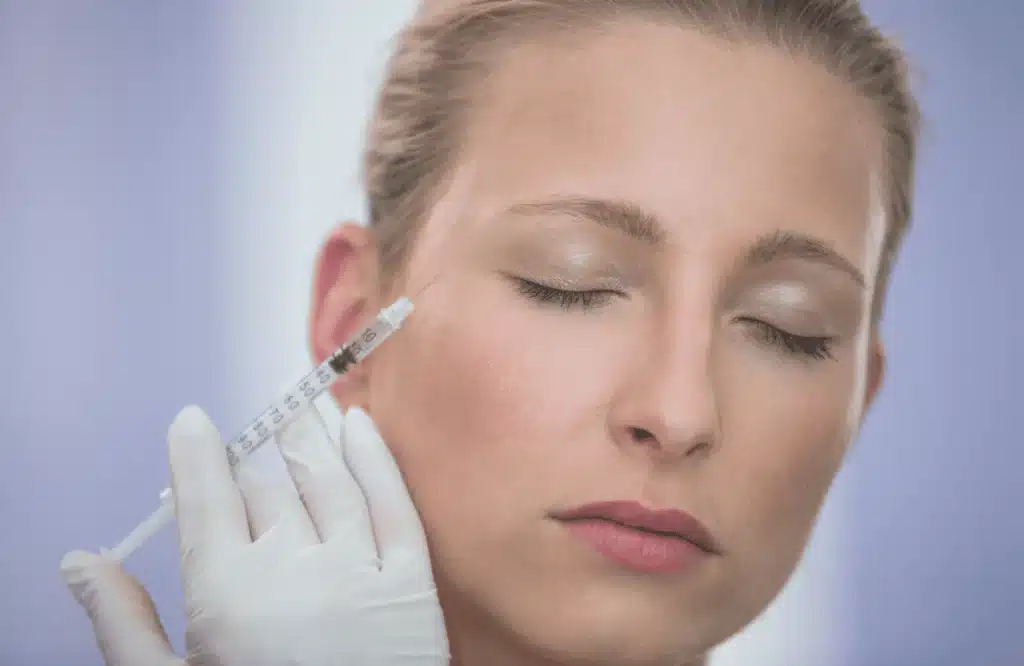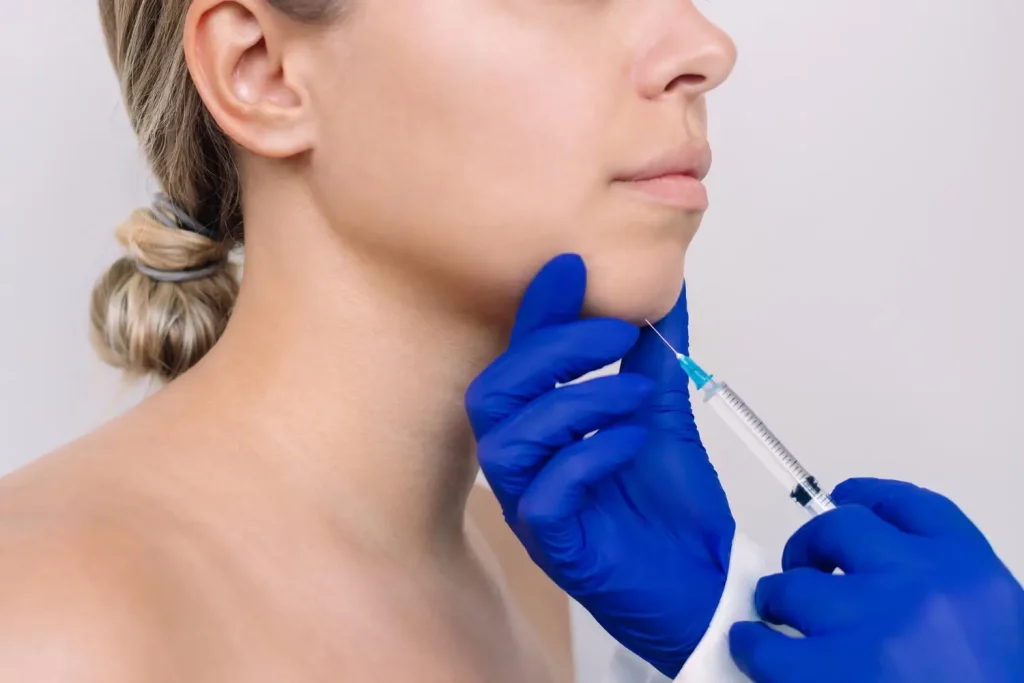Scars can appear on the skin area where the tissue has been damaged due to physical injury, surgery, or improper treatment. Sometimes, they occur after a specific disease, such as chicken pox or acne.
Not all cases of tissue trauma result in scarring, as the skin’s texture and color gradually return to their original state. But with deep skin injuries, rough scars can form.
Atrophic scars appear when there is insufficient collagen and elastin necessary for tissue formation. When scarring occurs, the normal topography of the skin is affected. These scars can be particularly noticeable, especially when they appear on exposed areas of the face and body. Since we typically consider them a cosmetic concern, correcting these scars often involves using fillers for acne scars. Today, we will discuss the role of fillers in addressing these cosmetic issues.
Why Use Dermal Fillers for Acne Scars?
Acne scars can cause significant distress for patients, affecting both their physical appearance and emotional well-being. Dermal fillers have emerged as a viable treatment option for certain types of acne scars, offering several benefits for scar management. Dermal fillers are injectable substances that augment soft tissue, providing volume and lift to depressed areas. For atrophic or depressed acne scars, such as rolling or boxcar scars, dermal fillers can help elevate the skin’s surface, effectively reducing the visible depth of the scars. By filling the indented areas, dermal fillers improve the skin’s overall contour, leading to a smoother appearance and diminished scar visibility.
Treating Acne Scars Using Dermal Fillers
Dermal fillers offer a targeted approach to acne scar treatment. Skilled dermatologists can strategically inject the fillers into the depressed regions of the acne scars, achieving a more uniform and aesthetically pleasing skin texture. The ability to perform localized treatments makes dermal fillers a versatile tool for managing individual acne scars, tailoring the approach to each patient’s unique scar pattern. This personalized treatment allows better scar blending with the surrounding skin, resulting in natural-looking outcomes.
Targeted Areas of Treatment
Dermal fillers can address various types of acne scars with precision. Both rolling scars, characterized by a wave-like appearance, and boxcar scars, with broad depressions and well-defined edges, can benefit from dermal filler treatments. Additionally, narrow and deep in appearance, certain ice pick scars may also respond positively to filler injections, although outcomes can vary. A comprehensive assessment is necessary for patients with a combination of acne scar types to determine the most effective areas for targeted treatment.
Which Fillers Can You Use for Acne Scars?
Several types of dermal fillers are available, each with distinct properties and applications for acne scar treatment. Hyaluronic acid (HA) fillers, such as Restylane and Juvederm, are commonly used due to their biocompatibility and reversibility. They offer a safe and temporary solution for addressing acne scars. HA fillers have the advantage of easy customization, allowing physicians to adjust the amount injected and achieve desired results. Additionally, some calcium hydroxylapatite (CaHA) fillers, like Radiesse, stimulate collagen production, leading to prolonged improvements in scar appearance. CaHA fillers are particularly useful in treating deeper acne scars and promoting tissue remodeling.
Risks and Side Effects
While dermal acne fillers are generally safe if administered by skilled practitioners, there are potential risks and side effects to consider. Common side effects include:
- Swelling;
- Bruising;
- Redness.
In some rare cases, patients may experience allergic reactions or infections. Healthcare professionals must discuss these potential complications with patients during the informed consent process.
Recovery and Aftercare
One of the benefits of using dermal fillers to treat acne scars is the minimal downtime. After the procedure, patients can usually resume their regular activities immediately. However, they should follow these aftercare instructions to ensure a smooth recovery process:
- For a few days, refrain from intense physical activity to minimize potential side effects.
- Limit excessive exposure to the sun or UV rays, which can help protect the skin and maintain the filler’s effects.
- Refrain from cosmetic treatments for a few days post-procedure to allow the filler to settle correctly.
Dermal Filler Alternatives for Acne Scars
While dermal fillers (face fillers) for acne scars can be effective for certain types of scars, it is essential to acknowledge that they may not be suitable for all types or some patient preferences. Therefore, dermatologists should consider a range of alternative treatment options tailored to the specific characteristics of the acne scars and the patient’s overall treatment goals. These options may include the following:
- Laser Resurfacing: Utilizing laser technology removes damaged skin layers and stimulates collagen production, aiding in scar reduction and overall skin rejuvenation.
- Micro-needling: Using tiny needles to create controlled micro-injuries in the skin, promoting collagen synthesis and minimizing the appearance of scars.
- Chemical Peels: Application of chemical solutions to exfoliate the top layer of skin, improving texture and reducing acne scars.
- Subcision: A surgical technique that breaks up fibrous scar tissue to release the tethered scars and stimulate collagen remodeling.
- Combination Therapies: Dermatologists may opt for a combination of treatments to optimize results. For instance, combining laser resurfacing with micro-needling or chemical peels can yield improved outcomes.
Long-term Outcomes and Maintenance
Dermal fillers provide temporary results, typically lasting several months to a year, depending on the type of filler used for acne scars and individual patient factors. Patients may find a need for periodic touch-up treatments with dermal fillers to maintain the desired improvements to facial scars. Encouraging regular follow-up appointments, along with educating patients on the importance of continued maintenance, contributes more to satisfactory long-term outcomes. Optimizing the patient’s skincare routine and addressing any underlying acne issues they may have, helps preserve the results and prevents new scar formation.
Patient Satisfaction and Psychological Impact
The improvement in acne scar appearance achieved through dermal fillers can profoundly impact patients’ self-esteem and overall well-being. Reducing the visibility of acne scars can increase confidence and positive self-image, benefiting patients both physically and psychologically. Patient satisfaction concerning acne scar dermal filler treatments is often high when the procedure is appropriately selected and administered. By understanding the patient’s aesthetic goals and managing expectations, healthcare professionals can ensure a positive treatment experience and enhanced quality of life for individuals struggling with acne scars.
Conclusion
Dermal fillers represent a valuable option for addressing atrophic or depressed acne scars, offering targeted and temporary improvements in scar appearance. Healthcare professionals can use these fillers strategically, customizing the treatment for each patient’s individual needs. While acne scar dermal fillers have demonstrated efficacy, discussing potential risks and alternatives with patients is essential to achieving the best possible outcomes and enhancing patient satisfaction. Providing comprehensive patient education on maintenance and follow-up care further contributes to long-term success and improved quality of life for individuals struggling with acne scars.
FAQ
Do fillers help with acne scars?
Yes. Dermal fillers can help with certain types of acne scars by filling in depressed areas and improving overall skin texture. However, they may not be suitable for all scar types or patient preferences. Other treatments like laser resurfacing, microneedling, chemical peels, or subcision may also be considered based on individual characteristics and treatment goals.
Which fillers are best for acne scars?
Hyaluronic acid fillers and collagen-stimulating fillers are commonly used to fill in acne scars. However, the best filler for each individual depends on the specific type and depth of the scars and should be determined by a qualified healthcare professional during a consultation.
Can filler fix a scar? Yes, fillers can help improve the appearance of scars by filling in depressed areas and providing temporary volume. However, the effectiveness of injections for acne scars depends on the scar type and depth. Deeper scars may require other treatments besides soft tissue fillers for acne scars.



















